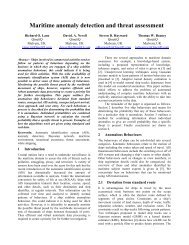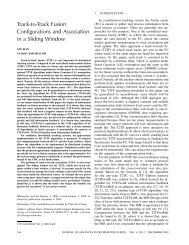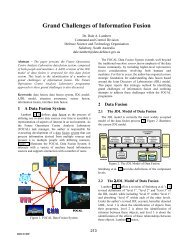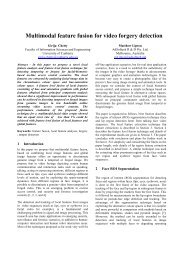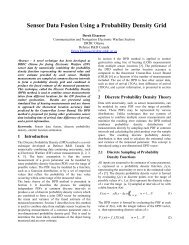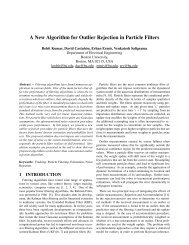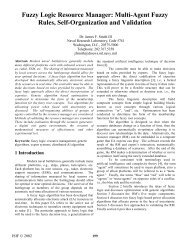Multiple Sensor Multiple Object Tracking With GMPHD Filter - ISIF
Multiple Sensor Multiple Object Tracking With GMPHD Filter - ISIF
Multiple Sensor Multiple Object Tracking With GMPHD Filter - ISIF
You also want an ePaper? Increase the reach of your titles
YUMPU automatically turns print PDFs into web optimized ePapers that Google loves.
ange tracking, and multiple speaker tracking are presented in<br />
the section V.<br />
II. PROBLEM FORMULATION<br />
The multi-sensor multi-object tracking problem can be<br />
modelled by random nite set (RFS) framework. Let X be<br />
the single object state space then multiple object state at<br />
time k is presented by X k = fx k;1 ; x k;2 :::; x k;Nk g 2 F(X ),<br />
where F(X ) denotes the collection of all nite subsets of the<br />
space X . For a multi-object state X k 1 at time k 1, each<br />
x k 1 2 X k 1 can continue to exist at time k with probability<br />
p S;k or die at time k with probability (1 p S;k ). Let S k (x k 1 )<br />
denote the object that is the transition from x k 1 at time k on<br />
condition that the object is survived and let B kjk 1 (x k 1 ) be<br />
objects spawned at time k from an object with previous state<br />
x k 1 . Let k be RFS of spontaneous births at time k and<br />
can be determined by using the assumption of spontaneous<br />
birth models. Given a multi-object state X k 1 at time k 1,<br />
the multi-object state X k at time k is given by union of the<br />
surviving objects and new objects,<br />
X k =<br />
h[ h[ i<br />
Sk (x k 1 )i<br />
[ Bkjk 1 (x k 1 )<br />
[ [ k] (1)<br />
The RFS X k encapsulates all aspects of multi-object tracking<br />
problem, such as time varying number of objects, object<br />
motion.<br />
Similarly, let Z i be the measurement space of single object<br />
at sensor i then measurements collected at sensor i time k is<br />
Zk i 2 F(Zi ). A given object state x k 2 X k is either detected<br />
with probability p D or missed with probability (1 p D ).<br />
Conditional on detection, the measurement from x k at sensor<br />
i is dened by the RFS i k (x k). The sensor i also can receive<br />
a set of clutters Ck i . So, given a multi-object state X k at time<br />
k, the measurement set from sensor i at time k is formed by<br />
the union of object generated measurements and clutters,<br />
" #<br />
[<br />
Zk i = i k(x k ) [ Ck i (2)<br />
x k 2X k<br />
Assuming that we have Q sensors, the RFS of measurements<br />
at time k is modelled by<br />
h<br />
i<br />
Z k = Zk; 1 Zk; 2 : : : ; Z Q k<br />
(3)<br />
The RFS Z k encapsulates all sensor characteristics such as<br />
measurement noise, sensor eld of view, clutter.<br />
The multi-sensor multi-object tracking can be posed as<br />
follows: given set of measurement Z 1:k collected from sensors<br />
up to time k, the problem is to nd ^X k is expectation or<br />
maximization of the posterior density function p(X k jZ 1:k ).<br />
III. PROBABILITY HYPOTHESIS DENSITY APPROACH<br />
In multiple object tracking problem, we usually need to<br />
obtain the posterior density p(X k jZ 1:k ). When the number<br />
of object increases, the multiple object state space become<br />
large. Hence, it is difcult to obtain the posterior density function.<br />
Fortunately, this density function can be approximately<br />
recovered from the probability hypothesis density (PHD) [9].<br />
The PHD is dened as follows. For a random nite set X on<br />
X with probability distribution P , the PHD is the density v(x)<br />
such that for each region S X , the integral of v over region<br />
S gives the expected number of elements of X that are in S,<br />
Z<br />
Z<br />
j X \ S j P (dX) = v(x)dx; (4)<br />
Thus, instead of estimating states of objects from posterior<br />
density, we can estimate them by investigating peaks of PHD.<br />
It helps to reduce from searching in multiple object state space<br />
to single object state space.<br />
IV. GAUSSIAN MIXTURE PROBABILITY HYPOTHESIS<br />
DENSITY FILTER IN MULTI-SENSOR MULTI-OBJECT<br />
A. Assumptions<br />
TRACKING<br />
First, there are some assumptions. The transition function<br />
of each object follows a linear Gaussian model, i.e.,<br />
f kjk 1 (xj) = N(x; F k 1 ; Q k 1 ) (5)<br />
where N(:; m; P ) denotes a Gaussian density with mean m<br />
and covariance P , F k 1 is the state transition matrix, Q k 1<br />
is the process noise covariance. There are Q sensors, the<br />
likelihood function at each sensor is also a linear Gaussian<br />
model, i.e.,<br />
g i k(zjx) = N(z; H i kx; R i k) (6)<br />
where H i k is the observation matrix of the sensor i, and Ri k is<br />
the observation noise covariance of the sensor i. The survival<br />
and detection probabilities are<br />
S<br />
p S;k (x) = p S;k (7)<br />
p D;k (x) = p D;k (8)<br />
The intensity of the spontaneous birth RFS is<br />
J ;k<br />
X<br />
k (x) =<br />
i=1<br />
w (i)<br />
;kN(x; m(i)<br />
;k ; P (i)<br />
;k ) (9)<br />
where J ;k is the number of birth Gaussian components at<br />
time k, and w (i)<br />
;k<br />
is the weight for i-th Gaussian component.<br />
The posterior intensity at time k 1 is a Gaussian mixture of<br />
the form<br />
v k 1 (x) =<br />
J<br />
X k 1<br />
i=1<br />
w (i)<br />
k 1<br />
N(x; m(i)<br />
k 1 ; P (i)<br />
k 1 ) (10)<br />
where J k 1 is the number of Gaussian components of posterior<br />
intensity at time k 1, and w (i)<br />
k 1<br />
is the weight for i-th<br />
Gaussian component.<br />
B. <strong>GMPHD</strong> lter with one sensor<br />
Vo [12] proposed a closed form expression of the PHD<br />
lter for linear Gaussian multi-object tracking, called the<br />
Gaussian mixture probability hypothesis density lter. Under<br />
assumptions in IV-A, the initial prior intensity is a Gaussian<br />
mixture, the posterior intensity at any subsequent time step is


